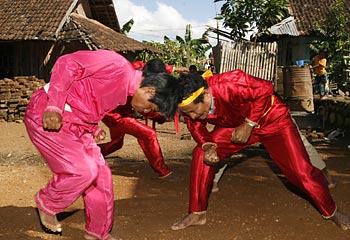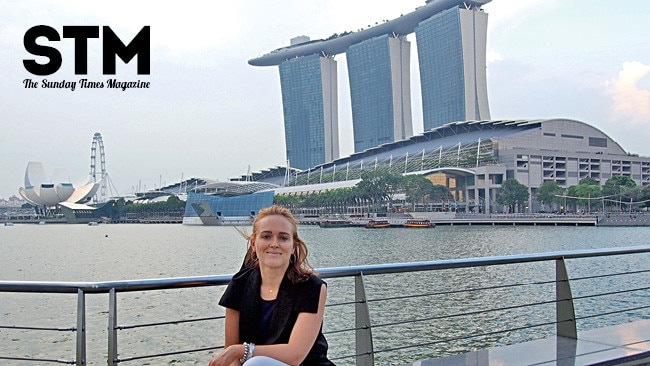Lair of dragons
CRAIG Tansley's cruise across Indonesia, from Bali to Rinca and Komodo to the east, takes him to remote islands, lost in time, where ancient curses still apply.

I ALMOST left disappointed. I'd heard dragon tales that had made my skin crawl, of prehistoric animals with clawed feet and razor teeth, that breathe no fire but whose bite guarantees certain death from septicemia.
I'd walked for hours in the Komodo National Park, and seen five of the creatures sneak away from our group. While they looked ugly, their lethargy made them look as threatening as overgrown tortoises.
Had I not seen an attack, I might have carried this disappointment away with me. But what I saw shook me. Without warning, one charged. Its quarry was a young guide, fishing from the pier on which our yacht was moored. His back was turned: he had no chance.
Sitting nearby, frozen like a cheap toy on Christmas morning, I was useless. Time slowed down. I screamed, finally.
The boy turned. It was nearly on him, covering the 30m pier in a heartbeat. A dragon generally goes for the legs of its larger victims, tearing the hamstring before attacking the throat and belly.
The boy jumped, a crew member from his boat reached out an arm and plucked him from mid-air, saving his life. The dragon stood there defiantly, irritated.
I've seen sharks at sea, I've seen a snake bite a friend, but nothing prepared me for the cold-blooded calculation of a Komodo dragon attack.
The islands of the Indonesian Archipelago, all 13,000 of them, stretch across one-eighth of the Earth's circumference through two oceans and across 5600km of sea. Most remain undiscovered by Western tourists.
Seeing them from the vantage point of a 36m traditional sail-rigged yacht makes me feel somehow heroic, like Captain Cook, albeit with a bottle of SPF30+ and a sensible hat.
Our journey will take us from Bali to Rinca and Komodo to the east, stopping at Lombok, Satonda, Pulau Bugis and Sumbawa along the way. In all, we cover just 50km of ocean, but this journey doesn't seem to be about kilometres – it's about time, about stepping back decades, even centuries.
Ancient curses still apply; centuries of strict Islam faith haven't stopped paganism; and on the island of Satonda the crew advise me to be careful. Ashaman, apparently, is buried here. Coral is hung off trees to warn off evil spirits, some more contemporary locals dangle thongs from branches.
Market stallholders in Bima, on the island of Sumbawa, marvel at my camera, and they giggle like children when they see themselves on the screen.
In the mountains just behind Bima, villagers engage in a bizarre ritual called head bumping. In a dirty market square, grown men, in bright traditional gowns that look like the silk pyjamas you find en masse in cheap Thai market stalls, run at each other's heads at full speed.
The noise the clash makes is nauseating, but they continue for what seems like hours, seemingly unaffected, though Iwonder what pain must be going through their battered brains.
Just west, on the east coast of Lombok, I'm sickened by the brutality of a stick fight between two teenagers: a ritual into manhood witnessed by the whole village. Each whack is applauded by 300 crazed children, the victor raising his arms to salute the baying crowd.
Life is hard here, only the strong survive, but there's a simplicity about it all I find infectious.
Days fly past as we venture further and further east, leaving everything we know far behind. The wind fills our sails, the sun beats down on us, townships on coastlines get fewer and further in between, until at last there's nothing but dragons.
It's the island of Rinca, and its neighbour, Komodo, that epitomise the diversity of the Indonesian archipelago.
Bali, Lombok and Sumbawa are your typical tropical island paradises, full to bursting with green jungles, monkeys and coconut trees. In the Komodo National Park, a night's sail east, it's the exact opposite: dry, barren, rocky and inhospitable, except for the two metre-long dragons that live nowhere else on this planet.
I assume there's some kind of enclosure to keep these animals at bay – or at least that our guides will be armed with rifles.
When we find two old men from the nearby island of Flores, dressed in tattered National Park clothing, carrying nothing more than a large stick, there is a muttering within our group.
But mythology is on our side: these men are blessed by the spirits of the dragons themselves and have permission to walk among them, apparently.
It doesn't take long before we're confronted by the beasts. Being cold-blooded, Komodo dragons need the strength of the sun to gather their energy, and being here in the early morning has guaranteed we'll leave the island in one piece.
From a distance they're frightening: massive jaws and fierce, sharp claws.
We head to the park's interior where monkeys screech as we pass and sea eagles glide overhead. We stop to watch a water buffalo resting in a swamp.
Our guide points to a puncture wound on its neck. "Dead," he says. The bite of a Komodo dragon is incredibly toxic, and a bite guarantees death from four types of bacteria.
A dragon will track the weakened animal, harassing it until it dies, sometimes it will track a large animal for up to four days before it collapses. "By tomorrow ..." the guide says, running his fingers along his throat.
The landscape is fitting for this creature. It looks like nowhere else on Earth. Tall, spindly lontar palms are the only trees that grow in this desert landscape and, combined with long brown grass, it feels like we're on safari in Africa.
We climb a hill and rest. Ahead of us is the most stunning vista I've seen.
The barren island gives way to an ocean of turquoise blue with our yacht sitting in the middle. All I can manage is to stare open-mouthed at it all.
Days pass; nights, full of stars, drift by.
I begin to find that while discovering this lost world is fascinating, I long for days and nights with nothing to do but sit and watch the world go by.
Sometimes pods of dolphins join us and, when I do tear myself away from the view, it's usually to enjoy a five-dollar massage on the sun deck from an Indonesian deckhand with hands as rough as a boxer.
When we disembark for beach barbecues, the sunsets and the solitude are overwhelming.
A week later we arrive back in Manoa Harbour, on Bali's east coast. Everything seems so modern, even on this relatively primitive Asian island.
Out there is a life we only just touched on; there's the wonder of seeing things as they were before the modern world ruled.
Spread across almost 5000km of untouched ocean there's a whole parallel universe waiting for the intrepid explorer. Most of us will never discover it – but, of course, that's the best part.
The writer was a guest of Garuda Indonesia.
The Sunday Telegraph



